Just one week on from my pilgrimage to London's art deco buildings from Southgate to Selfridges, I hit the road again to take a look at some more treasures of that most stylish genre, including some of London's best remaining examples of streamline moderne - a style that grew out of art deco, but rejected some of its more decorative elements. Some key features of the style include rounded edges, corner windows and smooth exterior surfaces.

My first stop was Ibex House (pictured above and below), which is probably my favourite London building. Tucked away at 42-47 The Minories, between Tower Hill and Aldgate, this huge structure was designed by architects Fuller, Hall and Foulsham These three also designed Blenstock House, the Bonhams building in the west end and which I wrote about here - and which was built in the same year as the Ibex. The Ibex is nine storeys high and clad in beige faience with the longest strip windows in London. It's curved walls were inspired by Erich Mendelsohn's Berlin Schocken department store. Walking along the Minories from Tower Hill, one is struck by its exquisite curves and clean lines and looking down either Hayden Street or Portsoken Street, there are additional treats in store with the spectacular glazed central stair turrets.
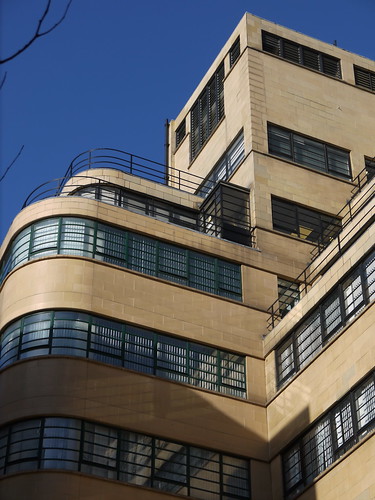
Today, Ibex House houses a number of businesses including a pub, a branch of a gym chain and a small Italian cafe which served me the strongest cup of coffee I have had in a very long time. The cafe retains what appear to be a number of original features in chrome and glass but best of all is the curved glass entrance that reminded me a little of the glazing on the former Simpson's Department Store on Piccadilly - now Waterstones. The cafe is a London style "caff" that sells "English breakfasts" as well as a selection of popular Italian treats and sandwiches. I am sure I can still feel the impact of that coffee - two days later. Great.

Moving on, a quick journey on the District Line from Tower Hill to Chancery Lane station followed by a short walk took me to Fleet Street, once the heart of Britain's newspaper industry. Most of the newspapers left in the 1980's - remember the mass picketing to oppose the moves from Fleet Street to Docklands and the increased automation of the printing process? Reuters held on until 2005 but the others were already long gone by then. What does remain however are some examples of art deco/ streamline moderne architecture that are still referred to by their former function.
The former Daily Express and Daily Telegraph buildings neighbour each other close to the Farringdon Road intersection of Fleet Street. My favourite of the two is the streamline moderne former Express building (pictured below), at number 133, built from 1930-32 and designed by architects Sir Owen Williams with Ellis and Clarke. The exterior features black vitrolite and a glass facade - which retains the "Express" name at ground floor level. I understand that the interior includes an incredible art deco entrance hall. Unfortunately this is off limits to all but employees and people with appointments. The interior relief panels were sculpted by Eric Aumonier, creator of the archer at East Finchley station.
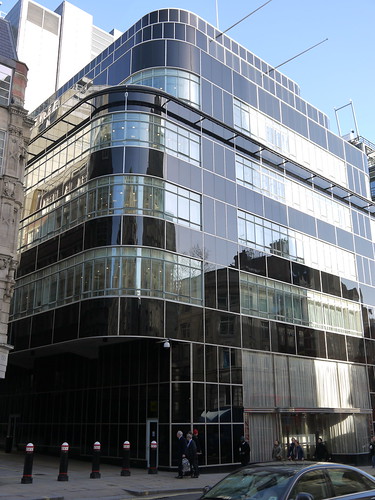
Today, both the former Express and Telegraph buildings belong to Goldman Sachs. The old Telegraph headquarters retains its colourful art deco clock hanging over Fleet Street, telling the time for city workers and tourists passing on open top buses. However the "Telegraph" legend has been removed from it, as has any clue to the former use of this building.
Turning off Fleet Street and along Farringdon Road towards the river leads to the new Blackfriars Underground Station which is just a few stops from St. James Park on the District Line and home to Broadway House, the nerve centre of London Underground. The station itself and the small shopping arcade leading to the platform retain a number of deco features, but the real treasures here are the sculptures on the exterior of the building. The upper levels of Broadway House are graced with sculptures by Henry Moore, Eric Gill and Samuel Rabinovich - but unfortunately these are so far up that its difficult to spot them and just about impossible to see the detail. Incidentally Rabinovich was an interesting character who in addition to being an artist was an Olympic bronze medallist, representing the United Kingdom at the Amsterdam Olympics in 1928 - in the wrestling competiton!
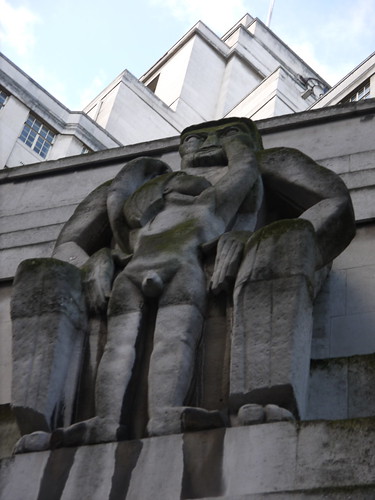
The real stars are a pair of sculptures by Jacob Epstein - Day and Night. Commissioned by Charles Holden to create these two pieces, Epstein was a controversial figure, subjected to vicious criticism for his work which often fell over into anti-semitism - this was the late 1930's after all, and the British press had its share of fascist supporters at this time. Once unveiled the sculptures caused a storm of controversy, one London Transport Passenger Board member board member offering to pay to have them removed, and Epstein being required to remove one and a half inches from the penis of the naked figure on "Day" (pictured above) before the furore died down! Its hard to believe that these two wonderful pieces could have excited such opposition. I particularly like the hooded figure of "Night" (pictured below) above the northern entrance. The Daily Express begged to differ describing it as "a prehistoric blood sodden cannibal intoning a horrid ritual over a dead body". Perhaps this says more about the "critic" than it did about the piece.
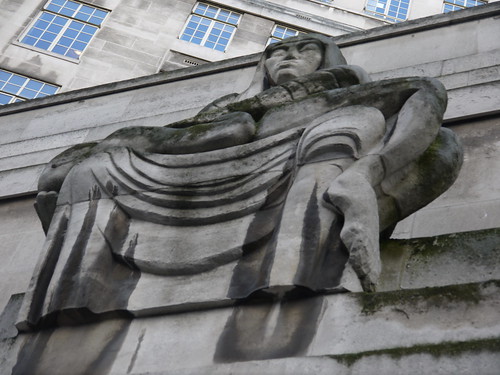
My final treat on this particular tour was a short walk away from Broadway House along Victoria Street - the Apollo Theatre, currently showing the musical "Wicked" in case you are interested, but which started life as the New Victoria Cinema. Built from 1928-1930, the theatre was designed by architects Ernest Warmsley Lewis and William E.Trent. Its hard to get a really good view (or photograph) of the theatre at the moment as the whole of this part of Victoria is a building site, but did get some shots of the two art deco silvered bas-relief panels depicting two distinct film genres on the exterior above either side of the exit doors. Both panels were the work of Newbury A. Trent - brother of one of the architects. A detail from one of the panels is pictured below.
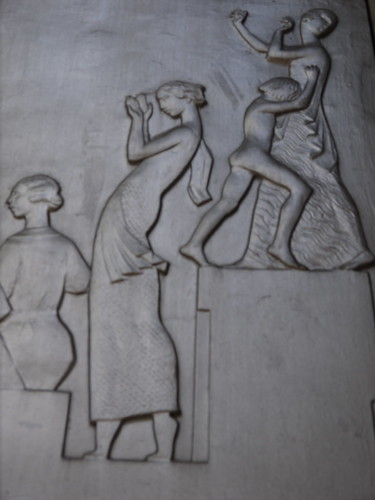

My first stop was Ibex House (pictured above and below), which is probably my favourite London building. Tucked away at 42-47 The Minories, between Tower Hill and Aldgate, this huge structure was designed by architects Fuller, Hall and Foulsham These three also designed Blenstock House, the Bonhams building in the west end and which I wrote about here - and which was built in the same year as the Ibex. The Ibex is nine storeys high and clad in beige faience with the longest strip windows in London. It's curved walls were inspired by Erich Mendelsohn's Berlin Schocken department store. Walking along the Minories from Tower Hill, one is struck by its exquisite curves and clean lines and looking down either Hayden Street or Portsoken Street, there are additional treats in store with the spectacular glazed central stair turrets.

Today, Ibex House houses a number of businesses including a pub, a branch of a gym chain and a small Italian cafe which served me the strongest cup of coffee I have had in a very long time. The cafe retains what appear to be a number of original features in chrome and glass but best of all is the curved glass entrance that reminded me a little of the glazing on the former Simpson's Department Store on Piccadilly - now Waterstones. The cafe is a London style "caff" that sells "English breakfasts" as well as a selection of popular Italian treats and sandwiches. I am sure I can still feel the impact of that coffee - two days later. Great.

Moving on, a quick journey on the District Line from Tower Hill to Chancery Lane station followed by a short walk took me to Fleet Street, once the heart of Britain's newspaper industry. Most of the newspapers left in the 1980's - remember the mass picketing to oppose the moves from Fleet Street to Docklands and the increased automation of the printing process? Reuters held on until 2005 but the others were already long gone by then. What does remain however are some examples of art deco/ streamline moderne architecture that are still referred to by their former function.
The former Daily Express and Daily Telegraph buildings neighbour each other close to the Farringdon Road intersection of Fleet Street. My favourite of the two is the streamline moderne former Express building (pictured below), at number 133, built from 1930-32 and designed by architects Sir Owen Williams with Ellis and Clarke. The exterior features black vitrolite and a glass facade - which retains the "Express" name at ground floor level. I understand that the interior includes an incredible art deco entrance hall. Unfortunately this is off limits to all but employees and people with appointments. The interior relief panels were sculpted by Eric Aumonier, creator of the archer at East Finchley station.

Today, both the former Express and Telegraph buildings belong to Goldman Sachs. The old Telegraph headquarters retains its colourful art deco clock hanging over Fleet Street, telling the time for city workers and tourists passing on open top buses. However the "Telegraph" legend has been removed from it, as has any clue to the former use of this building.
Turning off Fleet Street and along Farringdon Road towards the river leads to the new Blackfriars Underground Station which is just a few stops from St. James Park on the District Line and home to Broadway House, the nerve centre of London Underground. The station itself and the small shopping arcade leading to the platform retain a number of deco features, but the real treasures here are the sculptures on the exterior of the building. The upper levels of Broadway House are graced with sculptures by Henry Moore, Eric Gill and Samuel Rabinovich - but unfortunately these are so far up that its difficult to spot them and just about impossible to see the detail. Incidentally Rabinovich was an interesting character who in addition to being an artist was an Olympic bronze medallist, representing the United Kingdom at the Amsterdam Olympics in 1928 - in the wrestling competiton!

The real stars are a pair of sculptures by Jacob Epstein - Day and Night. Commissioned by Charles Holden to create these two pieces, Epstein was a controversial figure, subjected to vicious criticism for his work which often fell over into anti-semitism - this was the late 1930's after all, and the British press had its share of fascist supporters at this time. Once unveiled the sculptures caused a storm of controversy, one London Transport Passenger Board member board member offering to pay to have them removed, and Epstein being required to remove one and a half inches from the penis of the naked figure on "Day" (pictured above) before the furore died down! Its hard to believe that these two wonderful pieces could have excited such opposition. I particularly like the hooded figure of "Night" (pictured below) above the northern entrance. The Daily Express begged to differ describing it as "a prehistoric blood sodden cannibal intoning a horrid ritual over a dead body". Perhaps this says more about the "critic" than it did about the piece.

My final treat on this particular tour was a short walk away from Broadway House along Victoria Street - the Apollo Theatre, currently showing the musical "Wicked" in case you are interested, but which started life as the New Victoria Cinema. Built from 1928-1930, the theatre was designed by architects Ernest Warmsley Lewis and William E.Trent. Its hard to get a really good view (or photograph) of the theatre at the moment as the whole of this part of Victoria is a building site, but did get some shots of the two art deco silvered bas-relief panels depicting two distinct film genres on the exterior above either side of the exit doors. Both panels were the work of Newbury A. Trent - brother of one of the architects. A detail from one of the panels is pictured below.

This comment has been removed by a blog administrator.
ReplyDelete